| Dogue de Bordeaux | |||||||||||||||||||||||||||||
|---|---|---|---|---|---|---|---|---|---|---|---|---|---|---|---|---|---|---|---|---|---|---|---|---|---|---|---|---|---|
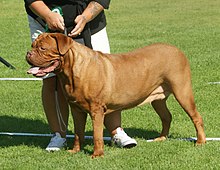 | |||||||||||||||||||||||||||||
| Other names |
| ||||||||||||||||||||||||||||
| Origin | France | ||||||||||||||||||||||||||||
| |||||||||||||||||||||||||||||
| |||||||||||||||||||||||||||||
| Dog (domestic dog) | |||||||||||||||||||||||||||||
The Dogue de Bordeaux, also known as the Bordeaux Mastiff, French Mastiff or Bordeauxdog, is a large French mastiff breed. A typical brachycephalic mastiff breed, the Bordeaux is a very powerful dog, with a very muscular body.
History
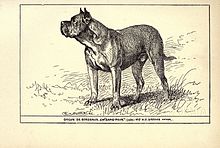
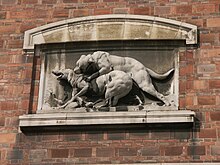
The Dogue de Bordeaux was known in France as early as the 14th century, particularly in southern France in the region around Bordeaux. Hence, the city lent its name to this large dog. The breed was first exhibited in France in 1863 after which time it gained in popularity not only in their home country but in other parts of the world. The first record of the Dogue de Bordeaux in the UK can be seen in the Kennel Club Gazette in 1897. The breed received championship status with the Kennel Club (UK) in 2016. A uniform breed type of the Bordeaux dog did not exist before about 1920.
The history of the breed is believed to predate the Bullmastiff and the Bulldog. It is said that the Dogue can be found in the background of the Bullmastiff, and others claim that the Dogue and mastiff breeds were both being accomplished at the same time. Another theory is the Dogue de Bordeaux originates from the Tibetan Mastiff and it is also said that the Dogue is related to the Greek Molossus used for war.
As there was a breed similar to the Dogue de Bordeaux in Rome at the time of Julius Caesar's reign, possibly a cousin of the Neapolitan Mastiff. Others suggest that the Dogue de Bordeaux is a descendant of a breed which existed in ancient France, the Dogues de Bordeaux of Aquitaine.
Breeding
| This section does not cite any sources. Please help improve this section by adding citations to reliable sources. Unsourced material may be challenged and removed. (February 2024) (Learn how and when to remove this message) |


In 1863, the first canine exhibition was held at the "Jardin d'Acclimatation" in Paris, France. The winner of the Dogue de Bordeaux was a female named Magentas. The Dogue de Bordeaux was then given the name of the capital of its region of origin, today's Dogue de Bordeaux.
During the 1960s, a group of breeders of the Dogue de Bordeaux in France, headed by Raymond Triquet, worked on the rebuilding of the foundation of the breed. In 1970, a new standard was written for the breed, with the most recent update in 1995. This standard is the basis of the standard written for the AKC in 2005.
Although the Dogue de Bordeaux first arrived in the USA in the 1890s for the show ring, the first documented Dogue de Bordeaux of modern times appeared in 1959 by the name of Fidelle de Fenelon. Between 1969 and 1980, imported Dogues de Bordeaux in the US were scarce, limited to a few breeders who worked closely with the French Dogue de Bordeaux Club, the SADB. The breed was first "officially" introduced to American purebred enthusiasts in an article written in 1982 by the American anthropologist Dr. Carl Semencic for Dog World magazine. When Semencic's first article on the breed was published, there were no Dogues de Bordeaux in the United States. There were 600 examples left in the world, mostly in France, the Netherlands and East Berlin, and the breed's numbers were on the decline. Much later, in 1989, the typical American family saw the Dogue de Bordeaux for the first time on the big screen in Touchstone's movie Turner & Hooch about a policeman and his canine partner.
Since then, the Dogue de Bordeaux has taken hold in the United States and can be found in greatly increasing numbers across the country. The Dogue de Bordeaux has been supported by multiple breed clubs throughout the years, and has finally found its way to full American Kennel Club recognition through the assistance of the Dogue de Bordeaux Society of America. Since 1997, the society has helped bring the breed to the point in which full AKC recognition could be achieved.
Appearance

The Dogue de Bordeaux is a well balanced, muscular and massive dog with a powerful build. The distance from the deepest point of the chest to the ground is slightly less than the depth of the chest. A massive head with proper proportions and features is an important characteristic of the breed. The breed is set somewhat low to the ground and is not tall like the English Mastiff. The body of the Dogue de Bordeaux is thick-set, with a top-line that has a slight dip (topline is never completely straight) and a gentle rounded croup. The front legs should be straight and heavy-boned, well up on pasterns, down to tight cat-like feet. The straight tail, beginning thickly at the base and then tapering to a point at the end, should not reach lower than the hocks, and is set and carried low. The breed is to be presented in a completely natural condition with intact ears, tail, and natural dewclaws. It should be evaluated equally for correctness in conformation, temperament, movement, and overall structural soundness.
Weight
The breed standards by European FCI and the AKC specify a minimum weight of 99 pounds (45 kg) for a female and 110 pounds (50 kg) for a male. There is no formally stated maximum weight, but dogs must be balanced with regard to their overall type and the conformation standards of the breed.
Height
The standard states that the desirable height, at maturity, should range between 24 and 27 inches (61 and 69 cm) for male dogs and from 23 to 26 inches (58 to 66 cm) for females. Deviation from these margins is considered a fault.
Head

The massive head is a crucial breed characteristic. The Dogue de Bordeaux is claimed to have the largest head in the canine world, in proportion to the rest of the body. For males, the circumference of the head, measured at the widest point of the skull, is roughly equal to the dog's height at the withers (shoulders). For females, the circumference may be slightly less. When viewed from the front or from above, the head of the Dogue forms a trapezoid shape with the longer top-line of the skull, and the shorter line of the underjaw, forming the parallel sides of the trapezoid. The jaw is undershot and powerful. The Dogue should always have a black or red mask that can be distinguished from the rest of the coat around and under the nose, including the lips and eye rims. The nose color in red-masked dogs should be brown, in black-masked dogs, it must be black. The muzzle should be at most a third of the total length of the head and no shorter than a quarter of the length of the head, the ideal being between the two extremes. The upper lip hangs thickly down over the lower jaw. The upper lips of the Dogue de Bordeaux hangs over the lower lips. The skin on the neck is loose, forming a noticeable dewlap, but should not resemble that of a Neapolitan Mastiff. Small pendant ears top the head, but should not be long and hound like.
Coat

The standard specifies the coat to be 'short, fine, and soft to the touch'. Color varies from shades of fawn (light, coppery red) to mahogany (dark, brownish red) with a black, brown, or red mask, although the red mask is true to the breed. White markings are permitted on the tips of the toes and on the chest, but white on any other part of the body is considered a fault, and a disqualifying one if the pigmentation goes beyond the neck.
Temperament
Much like other mastiff breeds, Dogues de Bordeaux tend to have a strong personality and are very stubborn. This mixed with their natural strength makes strict training crucial starting at a young age. This includes proper socialization so they do not end up with potential aggression towards other dogs or strangers. It is highly recommended that you do not let this dog become the leader of the family pack.
Health
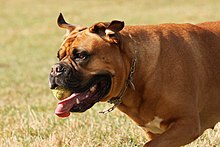
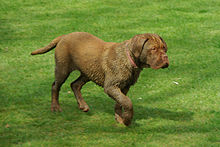
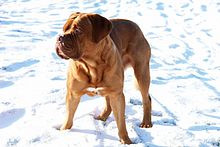
Life expectancy
A 2024 UK study found a life expectancy of 11.1 years for the breed compared to an average of 12.7 for purebreeds and 12 for crossbreeds.
Brachycephaly
The shortened snout and pushed in face of the Dogue de Bordeaux is known as brachycephaly. Brachycephaly results in deformation of the upper airway tract and leads to obstruction of breathing. Effects of brachycephaly are stridor, stertorous breathing, emesis, skin fold dermatitis, brachycephalic airway obstructive syndrome, exophthalmos, pharyngeal gag reflex, cyanosis, and laryngeal collapse. Other issues arising from brachycephaly are risk of complications whilst under anaesthesia, and hyperthermia — with the latter caused due to an inability to effectively reduce body temperature via panting.
Cardiovascular disease
Aortic stenosis is a disease of the heart valve in which the opening of the aortic valve is narrowed. One study suggests a high predisposition in the breed. No severe cases were found in adult dogs, and most moderate to severely affected dogs died before one year of age, leading the authors to speculate that the disease is more severe in the Dogue than in other breeds.
An Israeli study found the Dogue de Bordeaux to have the highest prevalence of tricuspid valve dysplasia, and the second highest prevalence of subaortic stenosis.
An Italian study found a predisposition to supraventricular tachyarrhythmia.
Other conditions
Demodicosis is more prevalent in the breed than other dogs. A study in the UK found 0.9% of dogs had the condition compared to the general rate of 0.17%. For dogs under 2 years it was prevalent in 1.9% compared to 0.48%. In dogs over the age of 4 it was prevalent in 0.2% of dogs compared to 0.05%.
An estimated 5% of dogs may be affected by footpad hyperkeratosis, a thickening of the footpad and sometimes nose. Lesions usually occur at the age of 6 months. The Dogue de Bordeaux is predisposed to hip dysplasia, with the prevalence ranging from 25.5% in the US, to 32.2% in France, and 47% in Finland.
Reproduction
Data from the Norwegian Kennel Club indicates a mean litter size of 8.1 puppies (ranging from 2-17) for the breed. The breed has a high stillborn and early neonatal mortality rate, with a stillborn rate of 14.2% and early neonatal mortality (death within 1 week from birth) of 10.4%. The average across all breeds in the study was 4.3% stillbirth and 3.7% early neonatal mortality. Excluding stillborn and early deaths, the mean litter size is 6.1. UK Kennel Club data shows that 27.8% (5 of 18) of Dogue litters were delivered by caesarean section.
See also
References
- "The Kennel Club". Retrieved 2016-11-26.
- "Dogue de Bordeaux". The Kennel Club. Retrieved 23 February 2024.
- "The history of the breed". Dogue de Bordeaux Club & Rescue. Archived from the original on 8 June 2023. Retrieved 20 April 2014.
- ^ Bell, Jerold (2012). Veterinary medical guide to dog and cat breeds. Kathleen Cavanagh, Larry Tilley, Francis W. K. Smith. Jackson, WY: CRC Press. p. 158. ISBN 9781482241419. OCLC 878262855.
- ^ Gino., Pugnetti (1980). Simon & Schuster's guide to dogs. Schuler, Elizabeth Meriwether. New York: Simon and Schuster. pp. 57. ISBN 0671255266. OCLC 6200215.
- ^ "Dogue de Bordeaux Dog Breed Information". American Kennel Club. Retrieved 2019-12-21.
- ^ "Official Standard of the Dogue de Bordeaux" (PDF). American Kennel Club. 9 October 2007. Retrieved 19 July 2015.
- "Dogues de Bordeaux". www.orvis.com. Retrieved 2022-02-26.
- "Dogue de Bordeaux". Vetwest Animal Hospitals. 2014-08-08. Retrieved 2022-03-24.
- McMillan, Kirsten M.; Bielby, Jon; Williams, Carys L.; Upjohn, Melissa M.; Casey, Rachel A.; Christley, Robert M. (2024-02-01). "Longevity of companion dog breeds: those at risk from early death". Scientific Reports. 14 (1). Springer Science and Business Media LLC: 531. Bibcode:2024NatSR..14..531M. doi:10.1038/s41598-023-50458-w. ISSN 2045-2322. PMC 10834484. PMID 38302530.
- Knecht, C. D. (1979). Upper airway obstruction in brachycephalic dogs. Compend Contin Educ Pract Vet, 1, 25-31.
- O’Neill, D. G.; Pegram, C.; Crocker, P.; Brodbelt, D. C.; Church, D. B.; Packer, R. M. A. (2020-10-14). "Unravelling the health status of brachycephalic dogs in the UK using multivariable analysis". Scientific Reports. 10 (1). Springer Science and Business Media LLC: 17251. Bibcode:2020NatSR..1017251O. doi:10.1038/s41598-020-73088-y. ISSN 2045-2322. PMC 7560694. PMID 33057051.
- Hendricks, Joan C. (1992). "Brachycephalic Airway Syndrome". Veterinary Clinics of North America: Small Animal Practice. 22 (5). Elsevier BV: 1145–1153. doi:10.1016/s0195-5616(92)50306-0. ISSN 0195-5616. PMID 1523786.
- TC, Amis; C, Kurpershoek (1986). "Pattern of breathing in brachycephalic dogs". American Journal of Veterinary Research. 47 (10): 2200–2204. ISSN 0002-9645. PMID 3777646. Retrieved 2024-02-06.
- Hendricks, J. C.; Kline, L. R.; Kovalski, R. J.; O'Brien, J. A.; Morrison, A. R.; Pack, A. I. (1987-10-01). "The English bulldog: a natural model of sleep-disordered breathing". Journal of Applied Physiology. 63 (4). American Physiological Society: 1344–1350. doi:10.1152/jappl.1987.63.4.1344. ISSN 8750-7587. PMID 3693167.
- Hendricks, Joan C. (1992). "Brachycephalic Airway Syndrome". Veterinary Clinics of North America: Small Animal Practice. 22 (5). Elsevier BV: 1145–1153. doi:10.1016/s0195-5616(92)50306-0. ISSN 0195-5616. PMID 1523786.
- Meola, Stacy D. (2013). "Brachycephalic Airway Syndrome". Topics in Companion Animal Medicine. 28 (3). Elsevier BV: 91–96. doi:10.1053/j.tcam.2013.06.004. ISSN 1938-9736. PMID 24182996.
- Lundgrun, Becky (26 June 2006). "Reverse Sneezing (Pharyngeal Gag Reflex)". VeterinaryPartner.com. Retrieved 26 December 2009.
- Sebbag, Lionel; Sanchez, Rick F. (2023). "The pandemic of ocular surface disease in brachycephalic dogs: The brachycephalic ocular syndrome". Veterinary Ophthalmology. 26 (S1): 31–46. doi:10.1111/vop.13054. ISSN 1463-5216. PMID 36585820.
- Hobi, Stefan; Barrs, Vanessa R.; Bęczkowski, Paweł M. (2023-06-16). "Dermatological Problems of Brachycephalic Dogs". Animals. 13 (12). MDPI AG: 2016. doi:10.3390/ani13122016. ISSN 2076-2615. PMC 10294810. PMID 37370526.
- Gruenheid, Michaela; Aarnes, Turi K.; McLoughlin, Mary A.; Simpson, Elaine M.; Mathys, Dimitria A.; Mollenkopf, Dixie F.; Wittum, Thomas E. (2018-08-01). "Risk of anesthesia-related complications in brachycephalic dogs". Journal of the American Veterinary Medical Association. 253 (3). American Veterinary Medical Association (AVMA): 301–306. doi:10.2460/javma.253.3.301. ISSN 0003-1488. PMID 30020004.
- Ewers Clark, Anna (2022-12-22). "Heatstroke and brachycephalic dogs – is there an increased risk?". Veterinary Evidence. 7 (4). doi:10.18849/ve.v7i4.534. ISSN 2396-9776.
- Kienle, Richard D.; Thomas, William P.; Pion, Paul D. (1994). "The Natural Clinical History of Canine Congenital Subaortic Stenosis". Journal of Veterinary Internal Medicine. 8 (6). Wiley: 423–431. doi:10.1111/j.1939-1676.1994.tb03262.x. ISSN 0891-6640. PMID 7884729.
- Höllmer, M.; Willesen, J. L.; Jensen, A. T.; Koch, J. (2008). "Aortic stenosis in the Dogue de Bordeaux". Journal of Small Animal Practice. 49 (9): 432–437. doi:10.1111/j.1748-5827.2008.00569.x. PMID 18684150.
- Ohad, D.G.; Avrahami, A.; Waner, T.; David, L. (2013). "The occurrence and suspected mode of inheritance of congenital subaortic stenosis and tricuspid valve dysplasia in Dogue de Bordeaux dogs". The Veterinary Journal. 197 (2). Elsevier BV: 351–357. doi:10.1016/j.tvjl.2013.01.012. ISSN 1090-0233. PMID 23434219.
- Locatelli, C.; Santini, A.; Bonometti, G. A.; Palermo, V.; Scarpa, P.; Sala, E.; Brambilla, P. G. (2011). "Echocardiographic values in clinically healthy adult dogue de Bordeaux dogs". Journal of Small Animal Practice. 52 (5). Wiley: 246–253. doi:10.1111/j.1748-5827.2011.01055.x. ISSN 0022-4510. PMID 21539569.
- O'Neill, D. G.; Turgoose, E.; Church, D. B.; Brodbelt, D. C.; Hendricks, A. (2020). "Juvenile-onset and adult-onset demodicosis in dogs in the UK: prevalence and breed associations". Journal of Small Animal Practice. 61 (1): 32–41. doi:10.1111/jsap.13067. ISSN 0022-4510. PMC 7003809. PMID 31584708.
- "Reasearch [sic] programe on Footpad hyperkeratosis in Dogue de Bordeaux". Antagene. Archived from the original on 1 June 2012. Retrieved 5 September 2012.
- "Naso-plantar keratoderma in the Dogue de Bordeaux: epidemiology, clinical and genetic data" (PDF). Laboratoire d'Anatomie Pathologique Vétérinaire du Sud-Ouest. Retrieved 29 December 2013.
- Gough, Thomas (2008). Breed predispositions to disease in dogs and cats. Oxford, UK: Wiley. p. 68. ISBN 9780470690802. OCLC 232611746.
- Roels, Joséphine; Genevois, Jean-Pierre; Fostier-Humbert, Mathilde; Porsmoguer, Charles; Blondel, Margaux; Chanoit, Guillaume; Fau, Didier; Cachon, Thibaut (2024-03-26). "Prevalence of elbow dysplasia in 13 dog breeds in France: a retrospective radiographic study (2002–2022)". American Journal of Veterinary Research. 85 (6): 1–8. doi:10.2460/ajvr.23.12.0290. ISSN 0002-9645. PMID 38518402.
- Borge, K. S.; Tønnessen, R.; Nødtvedt, A.; Indrebø, A. (2011). "Litter size at birth in purebred dogs—A retrospective study of 224 breeds". Theriogenology. 75 (5): 911–919. doi:10.1016/j.theriogenology.2010.10.034. PMID 21196028.
- Tønnessen, R.; Borge, K. S.; Nødtvedt, A.; Indrebø, A. (2012). "Canine perinatal mortality: A cohort study of 224 breeds". Theriogenology. 77 (9): 1788–1801. doi:10.1016/j.theriogenology.2011.12.023. PMID 22365700.
- Evans, K.; Adams, V. (2010). "Proportion of litters of purebred dogs born by caesarean section" (PDF). The Journal of Small Animal Practice. 51 (2): 113–118. doi:10.1111/j.1748-5827.2009.00902.x. PMID 20136998. Archived from the original (PDF) on 2016-04-06.
Further reading
- Dogue de Bordeaux, Janish, Joseph. Kennel Club Books, 2003. ISBN 1-59378-215-2
- The Saga of the Dogue de Bordeaux, Triquet, Raymond. Bas Bosch Press
- The World of Dogues De Bordeaux. Bas Bosch Press
External links